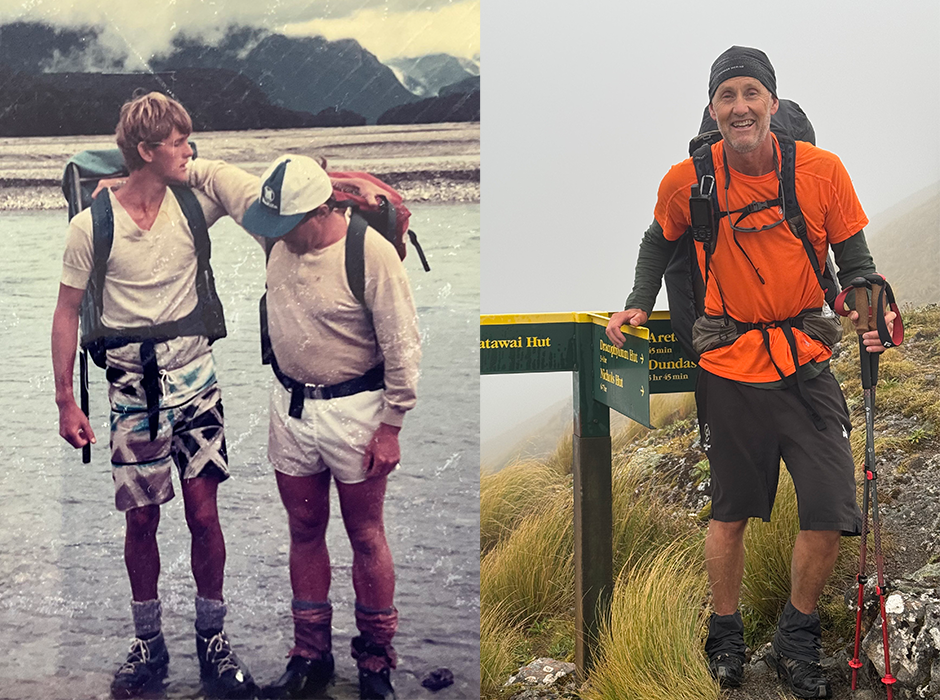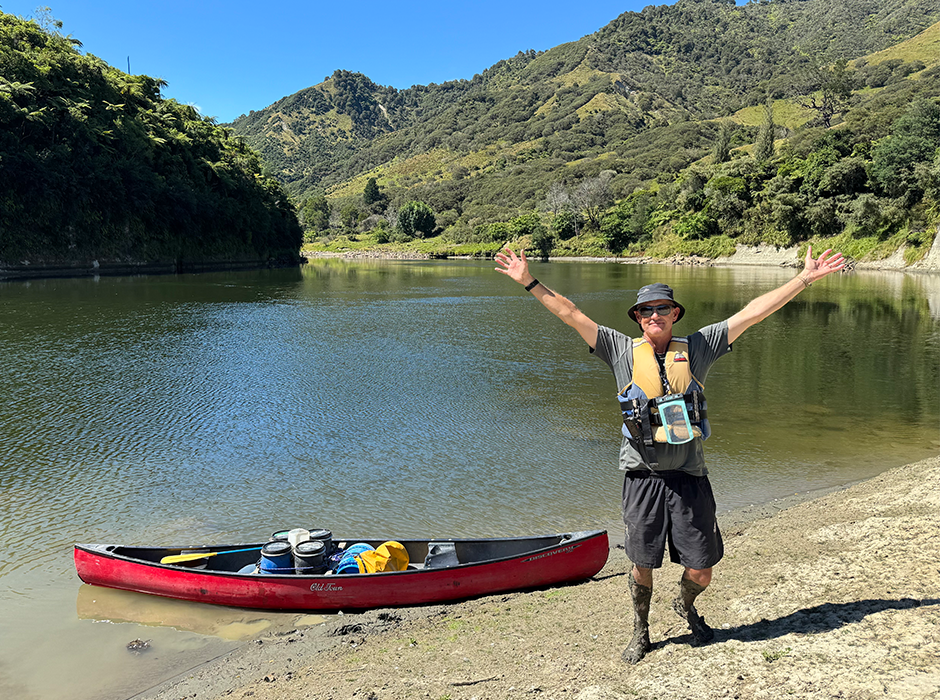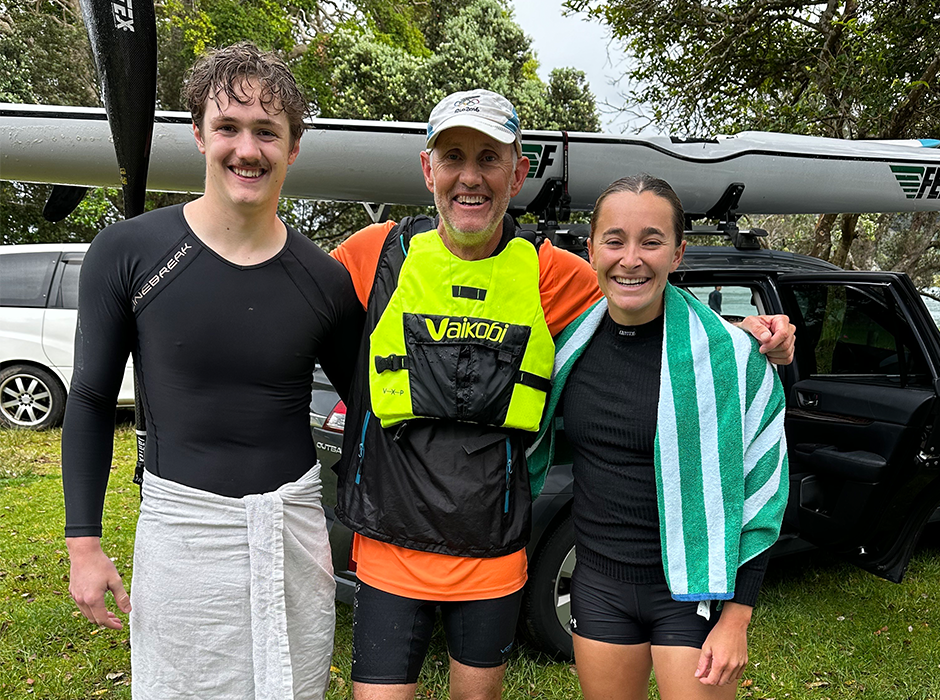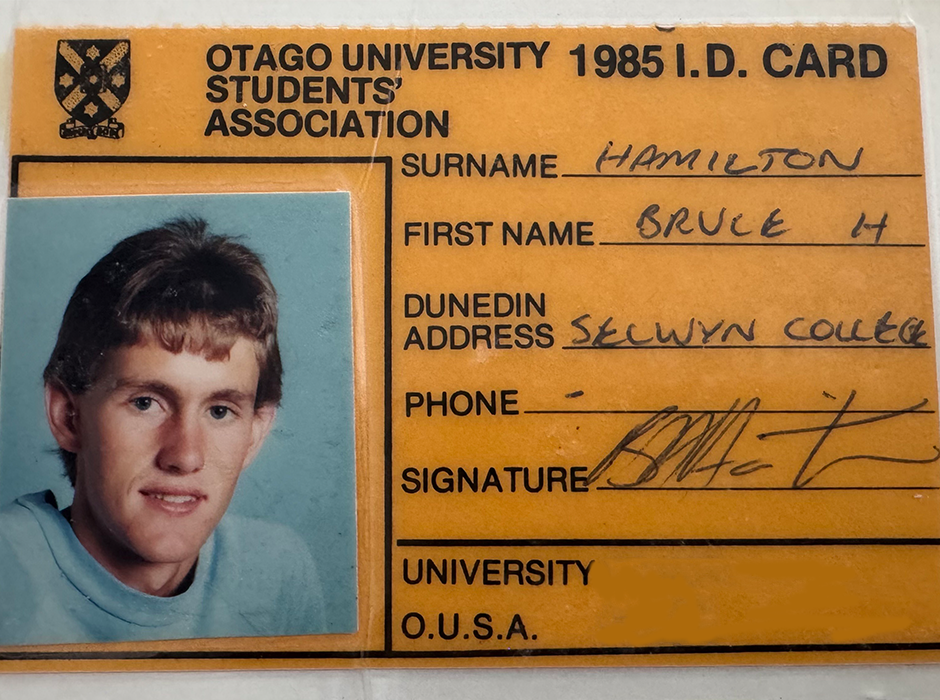
Otago alumnus Bruce Hamilton then and now. Left: Bruce goes through river crossing training during the 1986 Physical Education camp at Paradise. Right: Bruce on the Tararua Ranges section of Te Araroa.
Q&A with Dr Bruce Hamilton
We managed to catch former High Performance Sport NZ and Olympic Health team lead Bruce Hamilton in a gap while walking the 3,000 km Te Araroa (TA – The Long Pathway), as he took a break between finishing the trek through the Tararua Ranges and catching the ferry to start the South Island | Te Waipounamu leg of the journey.
The Otago physical education and medical graduate, recent High Performance Sport New Zealand (HPSNZ) health lead and three-time New Zealand Olympic Health team lead, decided last year that it was time for a change.
Rather than looking for a new job straight away, Bruce set himself the challenge of walking TA, which he combined with a personal mission to raise awareness of Huntington’s Disease.
What was the motivation behind your decision to, literally, walk away from what seems like a dream job?
Even in the best jobs you can find yourself getting stale and I've always enjoyed new challenges, new ways of looking at things. I think after three Olympic cycles I was probably starting to struggle to be as motivated or as excited about the next four-year Olympic cycle.
But moving on from a job that you've always really wanted to do and I am passionate about was not all that easy and I didn't have another job to go to. I didn't want to just leave with no purpose, so Te Araroa, which over the last 12 to 18 months I’ve become interested in, I saw as a great way to take me completely out of my comfort zone and make a clean cut from work.
Why kind of preparation did you do?
Whereas most people probably spend a lot of time planning for TA and all the technical side of it and all the training, I immersed myself in a lot of old walking literature. In particular I was interested in the previous people who have walked New Zealand.
History has over the last five or six years been my research interest, particularly around sport and sports medicine, so I'm sort of dovetailing, learning about New Zealand’s history as I'm walking. The trail is just incredible, and it takes you to places that I've never been to and that I never knew existed.

Bruce Hamilton on the Whanganui River section of Te Araroa.
What is behind your decision to raise awareness of Huntington’s Disease along the way?
We have Huntington's Disease in our family. It's a genetic disease with a 50 per cent chance of passing to any child of an affected parent, characterised by progressive mental deterioration and movement disorders that tend to appear in your 30s or 40s - insidiously stealing individual’s adult lives from them. My father suffered with it and my incredible mother cared for Dad for over 20 years. During much of that period, I was somewhat regrettably the absent son - at university or I was off to Australia and I was living the good life, largely able to avoid the prolonged realities of this progressive and tragic condition.
I was equally lucky when I eventually underwent genetic testing and essentially on the toss of a coin was negative for Huntington's. Such is how life is. Sadly, Huntington’s has now emerged in my generation and witnessing this has really brought home the tragic, wide-ranging and intergenerational impact of this horrid disease.
So, I'm working with the Huntington’s Disease Association to try and raise awareness and encourage support for research and the translation of that research to the benefit of those with Huntington’s and those supporting them. Unfortunately, prior to starting the walk, I’d never posted or used any form of social media so had no idea how to use ‘socials’ for a cause such as this. My kind niece Sarah Martin stepped up as my honorary and highly efficient ‘social media manager’.
What reaction have you had to your Instagram @brucewalksnz and Huntington’s Disease givealittle pages?
It's been really positive. I've never spoken publicly and rarely even in private about Huntington's Disease or its relationship to me and my family – only my closest friends have been aware. Over the last four months, this sort of ‘coming out of the closet’ has been somewhat revelatory for me, and to some degree for our family – being able to talk about it openly.
When you're walking with someone for five hours or more on TA, you cover a lot of ground, literally and figuratively. I have found people really interested and engaged in the topic and I’ve been touched by the compassion in relative strangers.
My approach with Instagram and Facebook has been pretty subtle, really just trying to use my time on the trail to keep Huntington’s sneakily in the ‘inbox’ using the remarkable scenery this country has.
The support from everyone has been amazing, helping me as I wander down the country, but most importantly my wife Tanya and children Jackson [who is studying exercise science at Otago] and Ella [studying exercise science in Australia] have been so supportive in encouraging me on the journey.
And how have you found the walk?
I would classify myself as an anti-walker for decades. I was a very average but enthusiastic runner at university and walking was always just like anathema. Even around the university we used to bike in order to avoid walking. In the last 30 years I can count on one hand how many days tramping I've done.
This was always going to be a challenge for me and it has been. I've definitely had days and moments where I've wondered whether I can make it.
I think in the first half of the North Island I was getting a bit excited about how fit I was getting, how far I was walking and I was probably getting a bit competitive – but I had to park that because I broke my foot on the section near Waitomo. It’s the day that I cried on TA.
But six weeks of rehabilitation and I managed to get walking again and I’m loving it. The people I’ve met, the views I’ve had, the time to reflect and learnings I’ve made, have all made it an amazing experience.

Bruce Hamilton, centre, with son Jackson and double Olympic gold medal paddler Alicia Hoskin. Jackson, who is studying exercise science at Otago, and Alicia joined him to paddle down the Puhoi River north of Auckland, part of Te Araroa. Alicia is the daughter of Physical Education graduates Craig (1985 class) and Toni (1986 class) Hoskin.
Can you tell us about your career before you became team doctor and health lead at HPSNZ?
Like most doctors, I did my junior years in the hospital, but I spent about three years over in Perth windsurfing and enjoying the beach life. But as happens after a while, everyone started down their professional specialisation process.
At that time, sports medicine specialisation (now the Australasian College of Sport and Exercise Physicians) was in its infancy and not really recognised as it is now. They had a Part 1 exam and a four-year training programme and I passed the exam over in Perth and was accepted onto the programme, initially working at Olympic Park Sports Medicine in Melbourne. That kickstarted what's been a fantastic joy ride over 25 years.
Getting onto the training programme was a bit of a shock (mainly as it meant I was going to have to actually study again!) and I actually deferred it for a year, travelled to the UK and completed a Tropical Medicine and Hygiene diploma – a helpful foundation for over 25 years later when supporting a New Zealand Olympic team during the Covid-19 Olympics in 2020!
One of the things that both PhysEd School and Medical School taught me was if you bring passion to your job and you love your job, then it’ll seem like you're not working at all. And I just loved what I was doing. I really enjoyed the people I was working with and the athletes I was supporting.
I think because of that I had lots of different opportunities. I ended up having 10 years in Australia, including five with the Australian Institute of Sport, at a time when the Olympics were in Sydney and Australian sport was on a high.
Then I was offered a role over in the UK and I worked with British Athletics for five years, at a time when they had many of the world’s leading track and field athletes. Being part of two Olympic Games with the British Olympic team was a great experience.
I also had five years in the Middle East in Qatar from 2008. They had just built a brand new shiny all bells and whistles sports medicine hospital and they were looking for sports doctors. That was an amazing opportunity to work in a really different culture, a really different environment and with a truly international team.
And from there you came back to New Zealand and started at HPSNZ in 2013?
The whole time I was away, wherever I was working but particularly with British or Aussie teams, I always said that I was just over there practising for when I got my real job back in New Zealand. Eventually an opportunity came up and I was really fortunate to lead the HPSNZ and New Zealand Olympic Committee health teams over the last 12 or so years.
It's been an amazing experience. I've been privileged now to have completed three Olympic and Commonwealth Games cycles in the New Zealand elite sport environment.
I think what differentiated New Zealand from other teams that I've been a part of has been the people. The team is small and the unique New Zealand culture is embedded into the fabric of the team – this has been a real learning process for me and something that I've absolutely loved.

Bruce Hamilton (in the beret) and the New Zealand Olympic Committee Core Health Team in Paris 2024. The team surprised Bruce by dressing up from their supply splints and bandages for the photo.
What stands out about your three New Zealand Olympic experiences?
Paris was incredible. The venues, the organisation, the weather, it was just spectacular and a really fantastic Olympic Games to be a part of. We had the best results New Zealand has ever had across a range of events. And from a health team perspective, I had the most amazing group of people to work alongside, all of which made it a unique Games experience.
Paris was a stark contrast to the Covid-19 plagued 2020 Olympics. These were a remarkably different games, with no spectators, little atmosphere, masks, hand sanitiser and Covid tests everywhere. There was an unbelievable amount of uncertainty in the lead in period with regard to what to expect, and lots of cynicism relating to the Games. The amount of communication and preparation required is just mind boggling when I look back now.
But I think, perhaps strangely, it's Rio that stands out the most for me.
When we arrived a few days ahead of the team, the Olympic Village where 400 athletes, coaches and staff were to live for three weeks was totally unfinished. It’s difficult to really explain the magnitude of the task of making it liveable, but I didn’t think it could be done – I was definitely committed, but I was glass-half-empty Bruce. We had 18 floors, four apartments on each floor, but you could not walk up the stairs because there was so much rubble on the stairs between floors, so every floor, 18 floors, you have to clear the rubble just to be able to figure things out.
The toilets didn't work. Showers didn’t work. It was still a construction site. The advance team of eight or nine of us were working 18-hour days, trying to get the space prepared, because we had less than six days to make it presentable.
I didn't think it would be possible but on the Sunday morning when the first 70 or 80 athletes and coaches and staff arrived and casually said, ‘Oh this isn't as bad as what we thought it would be’, it was an amazing relief and feeling of satisfaction and achievement. It was a great example of New Zealand at work, and I was so proud to be part of the New Zealand team – even before the Games began.
Can you tell us how you came to study at Otago?
I'm from Gisborne and was in a pretty small school there and sport was what I was interested in. As a 13-year-old, I went to a Dick Quax running camp and I met a physiologist, and his wife who was an elite runner, and I thought they were the coolest people that I had met.
So from then on, I wanted to try and do that. And PhysEd School was really the only place at the time that you could. I was super-excited to get accepted, no one in my family had ever been to university, no one really had any idea what I was doing or what it was all about.

Bruce Hamilton’s student ID card from 1985.
Did studying physical education at Otago meet your expectations?
I don't think I could ever have imagined it being as good as it was. It was a really special time. In fact, I've still got the letter of acceptance that Rex Thompson sent me in 1984.
It's fair to say that was a totally transformative moment. I went from being super keen but really having no idea in Gisborne, to getting to Otago and suddenly discovering that this is just an amazing place with amazing people and just so many opportunities.
I'm so grateful and feel so privileged to have had that opportunity, to be at PhysEd School at a really remarkable time.
For my first year, I was ensconced in Selwyn College, and I just thrived on it. It was sort of what you imagined university to be like in so many ways, and everyone felt so grown up, and I felt so naïve. It was just brilliant. I took every opportunity that came my way and grabbed it and ran with it.
What were some of the highlights of your time at Otago?
So many. There was a whole lot of academic learning that I absolutely loved. One of the things that Otago imprinted on me was wanting to be inquisitive. That inquisitiveness has stayed with me throughout my career.
Outside of that academic environment, the sporting environment at Otago was brilliant. I was involved with the Athletics and Harrier Club and that taught me a whole lot of skills – organisational skills, being involved with teams, communicating with different people. We had a lot of fun.
And the people that I got to meet at PhysEd School and at Med School have been my lifelong friends.
One of the great things that PhysEd taught me and which I took into Medical School was the importance of communication and the team environment.
For a career in medicine, being able to communicate with a wide range of different people in a lot of different circumstances, I certainly credit PhysEd School with a lot of that.
When did you decide you wanted to do medicine?
When I got down to Otago, I discovered all the stuff that I enjoyed had a very medical bent and realised the huge range of opportunities there were within medicine. With Sport Medicine in its infancy, and the growing awareness of the health benefits of exercise, I was excited by the potential to evolve my 13-year-old’s daydreams in that direction and early on I went and spoke with the now Emeritus Professor David Gerrard, one of New Zealand’s leading sports medicine doctors and Olympic team doctor in the 1980s – who was remarkably my regular doctor at the Student Health centre. He pointed me in the right direction.
With medicine, there's a lot of content, and after years of sitting in lectures, I struggled with the transition into clinical training. It seemed to take me ages to figure out how I needed to practise medicine to be effective.
I’ve always thought, probably inaccurately, that unknown individuals somehow judging my transition from physical education to medicine from the outside, would consider that while at PhysEd School I may have been ‘bright’, but not very ‘practical’. And then when I moved to medicine I was perhaps ‘practical’ but not very ‘bright’. There’s probably a few examples that back this up!
(Bruce also has a MD from Otago - his research focussed on muscle injuries, in particular hamstring injuries in the elite athlete environment.)
And any thoughts about what comes next for you?
I'm not retiring. There's just so many interesting things to look at and work on. I would love a role similar to what I've had in the past, combining clinical, research and teaching. I'm passionate about teaching and supporting research but have had less time in that space in recent years. Time will tell!
You’re heading to the PE 75th celebrations at the end of March. What are you most looking forward to?
Catching up. We've got a really strong group of friends from our intake in 1985, that have always kept in touch. We don't get together very often and I'm excited to see that group.
Also, I’m hopeful that there's a bunch of lecturers from that period there because I haven't seen most of them since I left. I'd love to have the opportunity to thank them for all they did for me, because they really set me up for a thoroughly enjoyable working career.
I'm excited to hear some of the stories and for the opportunity to say thank you to some great people.
Footnote: Shortly after we talked to Bruce, he fractured his foot just before the end of the Richmond Ranges and will have to put TA on hold for now, but he definitely plans to finish it in the future. Watch this space!